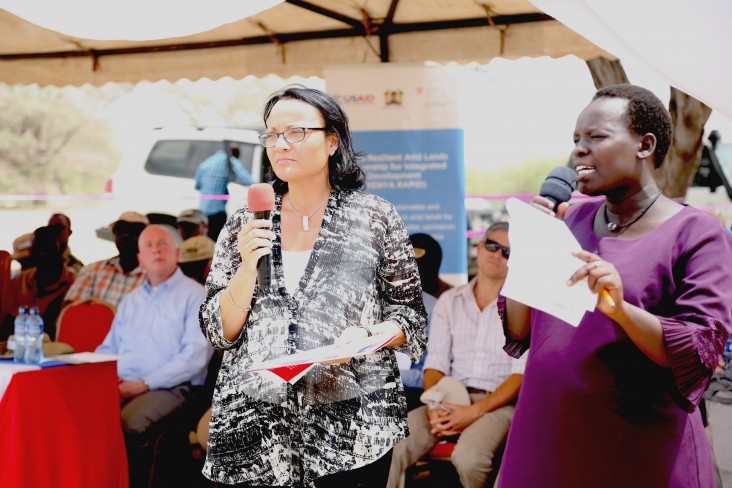Speeches Shim

It gives me great pleasure in joining you to commission the water utility at Lorengelup, in central Turkana. This is one of the many activities that USAID is supporting in the region. We are proud to be part of the support for the development of this particular water system that will enable more than 5,500 people to access water. Lack of access to safe water and sanitation services has direct health implications. Globally, more than 800,000 children die from diarrhea every year. Most of these deaths can be prevented through access to safe drinking water, adequate sanitation, and good hygiene.
In Kenya, approximately 18 million people still do not have access to drinking water. I applaud the progress that the Government of Kenya is making toward its constitutional provision defining water as a basic right. The United States is committed to helping Kenya improve water delivery to citizens at the local level. We have been partners for 50 years, and look forward to continuing our important work together on water and sanitation projects and on dozens of other issues.
The people of Kenya’s arid lands were severely affected by the droughts of recent years. The American people and other development partners responded generously with humanitarian assistance. However, we recognize that when counties face recurring natural disasters, both county leaders and citizens seek a more long-sighted response. That is why U.S. humanitarian assistance and development experts have looked at Kenya’s arid lands through a longer term lens, to focus on building resilience through targeted approaches to health and agriculture.
Undernutrition is a neglected condition in Kenya and northern counties like Turkana are the most affected. It contributes to one in three child deaths every year, and one in three children suffer from chronic undernutrition. The effects of undernutrition go beyond survival – the stunting of cognitive development associated with undernutrition causes poorer educational attainment and perpetuates the cycle of poverty in Kenya. The Government of Kenya has estimated that, from 2010 to 2030, under-nutrition will cost Kenya approximately $38.3 billion in lost GDP. If Kenya is to continue on a path towards middle income status, it must address the challenge of under-nutrition.
Water-related diseases such as diarrhea contribute to undernutrition because diarrheal disease affects a person’s ability to absorb key nutrients. Water-related diseases are the number one cause of under-five hospitalization and mortality in Kenya. More than 50 percent of hospital visits in Kenya are for preventable illnesses related to inadequate water, sanitation, or improper hygiene. Addressing the underlying causes of water-related diseases will reduce the burden on the health facilities in your counties and increase the productivity of the people of Kenya’s arid lands.
Partnering together to invest in health and education programs that will improve the survival, well-being, and productivity of the people of this great nation is a critical component of strengthening resilience in Kenya’s arid lands. By working together, we can make Kenya the leader it can be, and will be, in the 21st century. The Kenya Arid Lands Partnership for Integrated Development (Kenya RAPID) project works closely with other USAID projects to integrate water infrastructure projects in health facilities and communities where rural families are most at risk.
Why? Because Kenya’s most important resource is its people – the dynamic, ambitious Kenyans all around this country who will lead it in business, government, civil society, and academia in the years to come. In the past four years, I have had the privilege of visiting Turkana and Isiolo and have witnessed the good work that resilience partners are doing.
The partnership we are celebrating today will not only lead to sustainable economic growth over time, but also deliver social benefits to the entire country–especially to youth, women and the rural poor. I am proud the United States and Kenya are strong partners in the effort, and look forward to the great successes the future of these initiatives will have.
The United States Government remains a committed partner to Kenya to achieve new targets for water and sanitation under the Sustainable Development Goals. That is the reason I am joined with colleagues from Washington to reiterate the United States’ commitment to Kenya. Last year, the U.S. Ambassador to Kenya Robert Godec was here to launch this program and groundwater mapping projects in Turkana together with the Water Cabinet Secretary. We are happy to be back to see some of the completed activities. We will continue to align our support with the Government of Kenya water sector policies and plans, and we pledge our continued support to helping Kenya achieve its ultimate goal of universal access to water and sanitation.
Thank you.
Related Speeches
- Acting Administrator John Barsa’s Opening Remarks at Religious Leaders and Partners Roundtable in Kenya
- Acting Administrator John Barsa’s Remarks at W-GDP Roundtable and Announcement in Kenya
- Ambassador Godec Remarks at the Opening Ceremony of Lodwar Livestock Market and Water System, and Launch of USG Global Food Security Activity in Northern Kenya

Comment
Make a general inquiry or suggest an improvement.